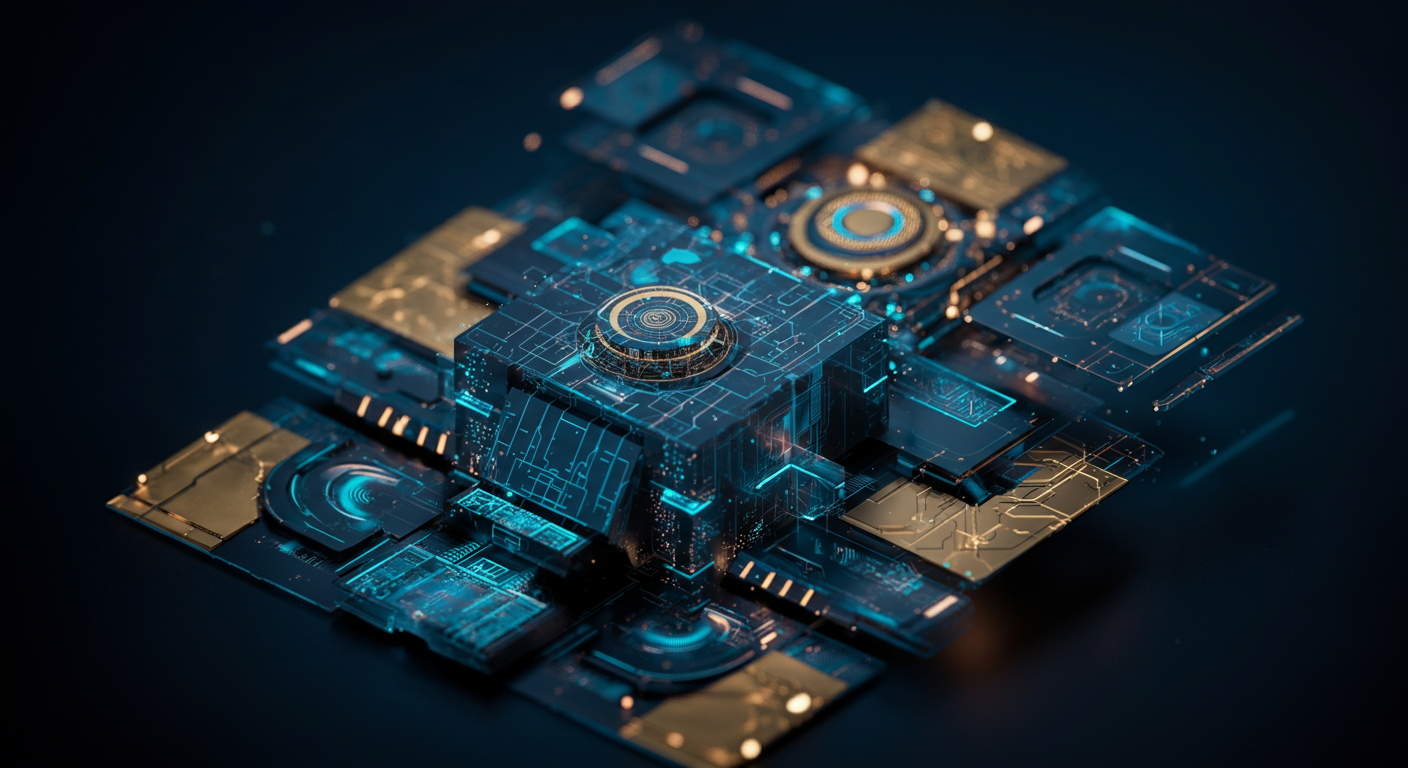MindJourney: A New Frontier in AI Spatial Intelligence Through Simulated 3D Worlds

MindJourney: Unleashing AI's Spatial Genius in Simulated Worlds
Imagine AI agents navigating the real world with the same intuitive understanding of space that we possess, thanks to innovative programs like MindJourney.
What is MindJourney?
MindJourney represents a pivotal AI research initiative concentrated on enhancing spatial understanding within artificial intelligence. This is achieved by:- Training AI agents within meticulously crafted, simulated 3D environments.
- Focusing on improving their spatial reasoning capabilities.
- Exploring applications in areas like virtual reality and robotics by searching Design AI Tools
Why Spatial Intelligence Matters
Spatial intelligence is crucial for AI to effectively interact with the physical world. This has massive implications for:- Robotics: Enabling robots to navigate complex environments, manipulate objects, and perform tasks with greater dexterity.
- Autonomous Driving: Improving self-driving cars' ability to perceive and react to their surroundings safely and efficiently. Consider exploring this topic further in our AI Explorer section.
- Virtual Reality: Creating more immersive and believable VR experiences by allowing AI to understand and react to virtual spaces realistically.
Why Now?
Advances in computing power and simulation technology have finally made training AI agents in complex 3D environments feasible. This convergence of factors allows initiatives like MindJourney to flourish, pushing the boundaries of AI capabilities. Furthermore, if you're a Software Developer, there are a number of tools and platforms to improve your processes.MindJourney isn't just about simulated spaces; it's paving the way for a future where AI understands and interacts with our physical world seamlessly. Now you can stay informed with the best AI news from Best AI Tools.
Simulated 3D environments are revolutionizing AI training, offering a playground where algorithms can learn without the constraints of the real world.
Control and Cost-Effectiveness
Why spend a fortune gathering real-world data when you can conjure up endless scenarios in simulation? Simulated worlds offer unparalleled control over the training environment. You dictate the rules, the variables, and the outcomes. This translates to:
- Scalability: Generate vast datasets quickly and efficiently.
- Cost Savings: Forget expensive data collection; simulations are economical. For instance, autonomous vehicle training benefits massively as it cuts costs and time drastically.
- Safety: Test dangerous scenarios without real-world risk.
The Power of Diversity
Simulations let you explore the improbable, pushing AI to its limits.
Imagine training an AI to navigate not just city streets, but also alien landscapes or post-apocalyptic ruins.
This diversity prepares AI for anything it might encounter, making it robust and adaptable. Want to train an AI in 3D generation without real-world constraints? Simulation makes it easy.
Addressing Data Bias
Real-world datasets often reflect existing biases, leading to skewed AI. Simulations offer a clean slate. By carefully crafting balanced datasets, we can mitigate bias and ensure fairness. This is crucial for applications like AI for privacy-conscious users where unbiased data handling is paramount.
Infinite Worlds with PCG
Procedural Content Generation (PCG) is the secret sauce. PCG algorithms can create an unlimited number of unique environments from a set of rules. This means AI can train on an infinite stream of novel scenarios, preventing overfitting and enhancing generalization. Check out related tools in the Design AI Tools category for inspiration.
In essence, simulated 3D environments are the ultimate AI training ground, offering control, scalability, and the chance to create a more robust and unbiased future. Next, let’s see how these environments enhance MindJourney's spatial intelligence.
MindJourney is more than a game; it's a laboratory for spatial AI.
How MindJourney Works: Deep Dive into the AI Architecture
At its core, MindJourney employs a sophisticated blend of reinforcement learning (RL) and neural networks. RL provides the framework for agents to learn through trial and error, while neural networks enable them to perceive and interact with their virtual surroundings. Imagine teaching a dog new tricks, but instead of treats, the reward is optimized navigation and problem-solving!
Creating and Navigating Simulated Worlds
The 3D environments within MindJourney aren't just randomly generated; they're meticulously crafted using procedural generation techniques and neural radiance fields (NeRFs). This allows for efficient creation of diverse and realistic spaces, from bustling cityscapes to serene natural landscapes. The AI agents navigate these environments using a combination of:
Pathfinding algorithms (A\, Dijkstra's) for high-level planning
- Deep neural networks for low-level motor control
The Reward System
The reward system in MindJourney is designed to incentivize specific behaviors. For example:
AI agents might receive positive rewards for reaching a destination, solving a puzzle, or avoiding obstacles, and negative rewards for collisions or inefficient paths.
This encourages the development of adaptive and intelligent navigation strategies. Think of it as a constant feedback loop, shaping the AI's actions towards optimal performance. And by using a curriculum learning approach, the challenges become gradually more complex.
Sim-to-Real Transfer

The ultimate goal is to transfer the knowledge gained in simulation to real-world applications. However, "Sim-to-Real" transfer is one of the biggest challenges. AssemblyAI, while not directly related to simulation, offers a good analogy here -- just as they need to ensure speech recognition models trained on clean audio can understand noisy real-world recordings, MindJourney researchers must address the gap between perfectly simulated and messy real-world environments. Strategies include:
- Domain randomization: Introducing variations in the simulation to make it more robust.
- Adversarial training: Forcing the AI to learn from increasingly challenging scenarios.
One could argue that MindJourney's spatial intelligence opens doors we didn't even know existed, but let's get down to brass tacks.
Robotics: Giving Robots a Brain... Sort Of
Navigation: Imagine a robot vacuum cleaner that actually* understands the layout of your house, not just bumping into things. MindJourney equips robots with the ability to navigate complex environments without pre-programmed routes.
- Object Manipulation: Think robotic arms in factories. Instead of being limited to repetitive tasks, they can adapt to picking up oddly shaped objects with ease.
Autonomous Driving: Smarter Cars, Fewer Accidents
- Perception: MindJourney enables cars to "see" the world in 3D, leading to improved object recognition, especially in adverse weather conditions, making your drive safer.
- Path Planning: Ever wonder how a self-driving car decides which lane to be in? This technology could make decisions smarter and faster, especially in dense urban environments.
Virtual and Augmented Reality: Immersion Level: Expert
- Realistic Environments: Creating virtual worlds has always been labor-intensive. Spatial AI can automate much of this, generating incredibly detailed and interactive 3D environments.
Urban Planning and Smart Cities: Building a Better Tomorrow
- Traffic Optimization: By simulating traffic flow in 3D, urban planners can identify bottlenecks and optimize traffic light timing. It's like playing SimCity, but with real consequences (for the better, of course).
- Resource Allocation: Imagine a city that dynamically adjusts resource allocation based on real-time simulations, optimizing everything from energy consumption to waste management.
Spatial intelligence in AI, allowing systems to "understand" and interact with 3D environments, is rapidly evolving, but still faces considerable hurdles.
The Limits of Perception
Current AI struggles to match human intuition when interpreting spatial relationships.
- Data Dependency: Most AI models rely on massive datasets for training, making them susceptible to bias or failure in unfamiliar environments. Consider self-driving cars, which can be flummoxed by unexpected road conditions or poorly marked streets.
- Computational Intensity: Processing 3D data is computationally expensive. Extracting meaningful information from raw sensor data requires significant processing power. This is why AI scientific research is focusing on creating efficient algorithms for spatial analysis.
Research and Ethical Boundaries
Ongoing research is pushing the boundaries of what AI can "see" and understand, but with increased capability comes increased responsibility.
- Improving Reasoning: Researchers are developing new architectures that combine neural networks with symbolic reasoning to enhance AI's spatial understanding.
- Ethical Considerations: As AI becomes more adept at spatial analysis, ethical dilemmas arise, especially concerning surveillance, privacy, and potential misuse of the technology. Imagine the implications for automated surveillance systems powered by advanced spatial AI.
MindJourney's Vision and Open Collaboration
The long-term vision for tools like MindJourney involves creating immersive simulated worlds for training AI and testing spatial reasoning. This includes 3D generation to create realistic, simulated environments.
- Community Involvement: Open-source collaboration is crucial for democratizing access to spatial AI and accelerating innovation.
- Transformative Potential: MindJourney and similar platforms could revolutionize fields like robotics, urban planning, and environmental monitoring.
MindJourney's innovative spatial AI approach is reshaping how we interact with digital environments.
MindJourney’s Simulated Edge
Unlike traditional AI spatial interpretation, which relies heavily on real-world data, MindJourney leverages simulated 3D worlds. This offers several key advantages:- Data Abundance: Infinite scenarios can be generated, overcoming data scarcity issues. Think of it like a limitless training ground.
- Controlled Environments: Precisely manipulate variables to isolate and understand specific spatial relationships. This level of control is invaluable for research.
- Reduced Bias: Real-world datasets often contain inherent biases. Simulated environments allow for the creation of perfectly balanced datasets.
Architecture & Advantages
MindJourney employs a unique AI architecture combining 3D Generation AI Tools with advanced reasoning capabilities. This leads to:- Enhanced Spatial Understanding: The AI can not only recognize objects, but also understand their relationships within a simulated environment with impressive accuracy.
- Rapid Prototyping: The ability to quickly generate and analyze different spatial layouts makes it invaluable for applications like urban planning and architectural design.
- Accessibility: MindJourney's focus on simulation opens up possibilities for use cases where real-world data collection is impractical or unethical.
Comparing MindJourney

| Feature | MindJourney | Traditional Spatial AI |
|---|---|---|
| Data Source | Simulated 3D environments | Real-world datasets |
| Bias Mitigation | High (controlled dataset generation) | Low (inherent biases in real-world data) |
| Application | Design, robotics, training | Navigation, object recognition |
| Strengths | Controlled research, data abundance | Strong in real-world application |
| Weaknesses | Requires abstract transfer to the real world | Limited by real-world data quality and availability |
It is important to note that while MindJourney excels in controlled simulations, the challenge lies in effectively transferring this learned spatial intelligence to the complexities of the real world.
MindJourney's innovative use of simulated environments offers distinct advantages, positioning it as a powerful tool for spatial AI research and development, however, remember to check out the Best AI Tools for a comprehensive overview.
Navigating the realm of AI spatial interpretation can feel like stepping into a simulated 3D world, but fret not, I've got a few pointers to get you started.
Diving Deeper: Resources to Explore
- Research Papers: Sites like Arxiv.org are treasure troves. Search for keywords like "neural radiance fields," "3D reconstruction AI," or "spatial reasoning AI." This is where the theoretical rubber meets the road.
- Online Courses: Platforms like Coursera, Udacity, and edX offer courses on computer vision, deep learning, and robotics. These will provide the foundational knowledge necessary for understanding spatial AI. Don't underestimate the value of a solid AI Fundamentals course.
- Community Forums: Join communities like Reddit's r/MachineLearning or the Stack Overflow AI section. These are great places to ask questions and engage with fellow learners.
Essential Tools and Libraries
- TensorFlow and PyTorch: These are the bread and butter of AI development. Both offer excellent support for 3D data and neural network architectures.
- Open3D: An open-source library for 3D data processing. It provides tools for tasks like point cloud registration, mesh reconstruction, and visualization.
- CUDA: If you're serious about training large models, you'll want to leverage the power of NVIDIA GPUs. CUDA allows you to write code that runs directly on the GPU.
- Unity and Unreal Engine: For simulating 3D environments and creating interactive AI applications, these game engines are invaluable. Think of them as your AI playground.
Getting Involved and Contributing
- Open Source Projects: Look for open-source projects on GitHub related to MindJourney or similar spatial AI initiatives. Contributing code, documentation, or even just reporting bugs is a fantastic way to learn.
- Community Contributions: Check if MindJourney has a dedicated forum or discussion group. Sharing your progress, asking questions, and offering help to others is a great way to connect with like-minded individuals. Remember, AI is a collaborative endeavor!
In essence, mastering AI spatial interpretation is about combining theoretical knowledge with practical application. Start small, experiment often, and don't be afraid to break things along the way. Now, go forth and create! Next up, we will explore MindJourney's potential in virtual tourism.
Keywords
MindJourney AI, AI spatial interpretation, simulated 3D worlds AI, AI training environments, deep learning spatial reasoning, reinforcement learning 3D, AI navigation, AI simulation, spatial AI, artificial intelligence, 3D world simulation, AI agents, virtual environments AI
Hashtags
#AISpatialIntelligence #MindJourneyAI #SimulatedWorlds #AIResearch #DeepLearning
Recommended AI tools
ChatGPT
Conversational AI
AI research, productivity, and conversation—smarter thinking, deeper insights.
Sora
Video Generation
Create stunning, realistic videos and audio from text, images, or video—remix and collaborate with Sora, OpenAI’s advanced generative video app.
Google Gemini
Conversational AI
Your everyday Google AI assistant for creativity, research, and productivity
Perplexity
Search & Discovery
Clear answers from reliable sources, powered by AI.
DeepSeek
Conversational AI
Efficient open-weight AI models for advanced reasoning and research
Freepik AI Image Generator
Image Generation
Generate on-brand AI images from text, sketches, or photos—fast, realistic, and ready for commercial use.
About the Author

Written by
Dr. William Bobos
Dr. William Bobos (known as 'Dr. Bob') is a long-time AI expert focused on practical evaluations of AI tools and frameworks. He frequently tests new releases, reads academic papers, and tracks industry news to translate breakthroughs into real-world use. At Best AI Tools, he curates clear, actionable insights for builders, researchers, and decision-makers.
More from Dr.

